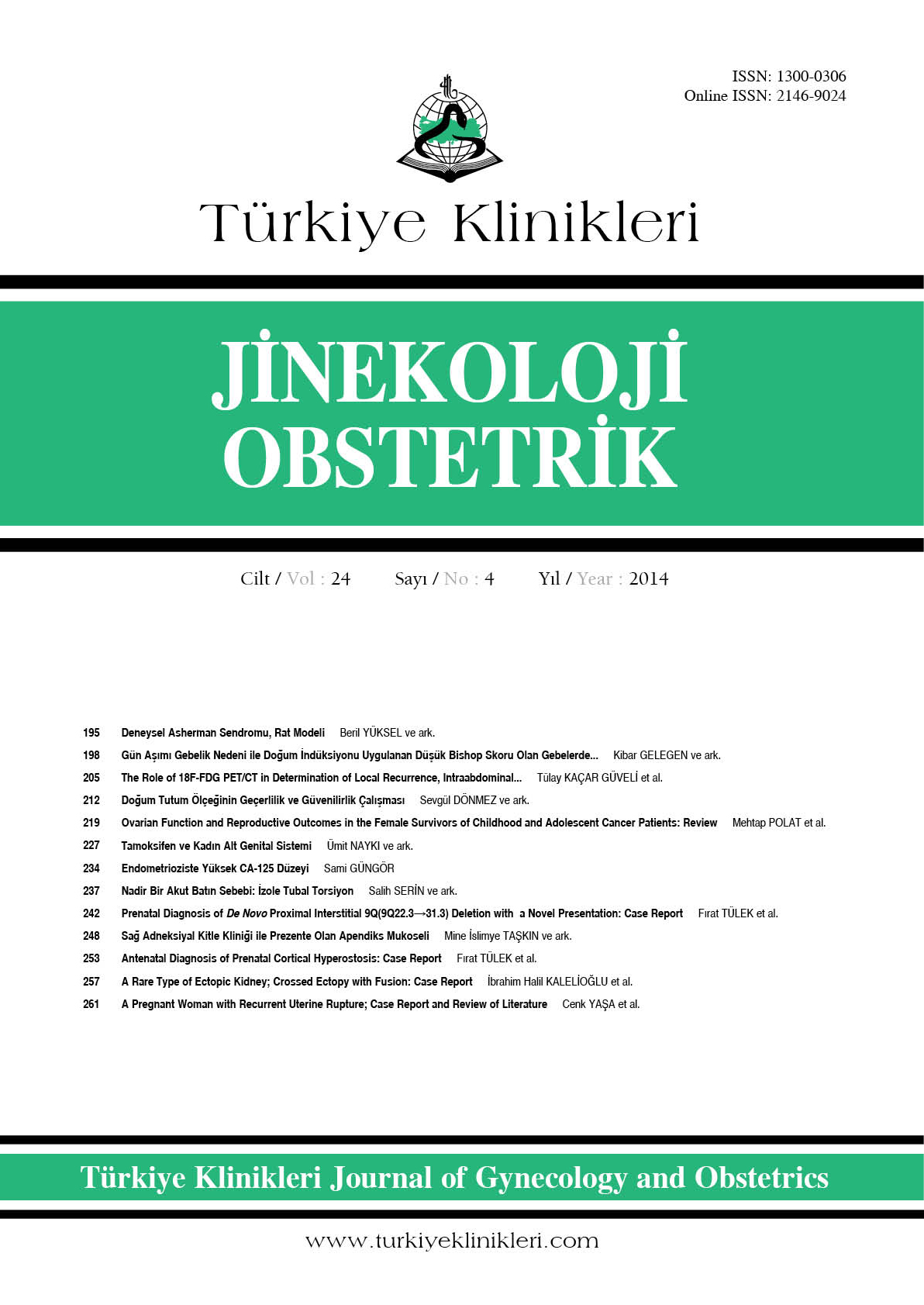Open Access
Peer Reviewed
CASE REPORTS
3467 Viewed2020 Downloaded
A Rare Cause of Acute Abdomen: Isolated Tubal Torsion: Case Report
Nadir Bir Akut Batın Sebebi: İzole Tubal Torsiyon
Turkiye Klinikleri J Gynecol Obst. 2014;24(4):237-41
Article Language: TR
Copyright Ⓒ 2025 by Türkiye Klinikleri. This is an open access article under the CC BY-NC-ND license (http://creativecommons.org/licenses/by-nc-nd/4.0/)
ÖZET
İzole tubal torsiyon; jinekolojik aciller arasında 1/1 500 000 insidansı ile oldukça nadir görülen bir akut batın sebebidir. İlk tubal torsiyon olgusu 1980 yılında Bland-Sutton tarafından tanımlanmıştır. Genellikle sağ tubada izlenir. Akut apandisit, ektopik gebelik ve over kist torsiyonu ile karıştırılmaktadır. Ektopik gebeliğin dışlanması için gebelik testinin negatif olduğunun görülmesi gerekir. Adneksiyal alanların ultrason ile incelemesinde overlerin normal olarak izlendiği ve uterin korna doğru uzanım gösteren kitle varlığında akla bu anomali getirilmelidir. Manyetik rezonans görüntüleme ve bilgisayarlı tomografi tanıda kullanılabilir. Erken tanısının konulması ve cerrahi uygulanması halinde tubanın korunması olasıdır. Tedavide laparoskopi en sık tercih edilen tedavi prosedürü olmasına rağmen, laparotomi de sık uygulanmaktadır. Tanıda geç kalınmış veya kliniği geç oturan olgularda ise tubada nekroz gelişmekte ve bu hasta grubunda salpinjektomi yapılması gerekmektedir. Bizim olgumuzda; hasta kliniğine karın ağrısı şikâyeti ile başvurdu. Akut batın nedeni ile laparotomi yapılan ve izole tubal torsiyon saptanan hastamızda, yapılan gözlemde tubanın nekroze olduğu görülerek salpinjektomi yapıldı.
İzole tubal torsiyon; jinekolojik aciller arasında 1/1 500 000 insidansı ile oldukça nadir görülen bir akut batın sebebidir. İlk tubal torsiyon olgusu 1980 yılında Bland-Sutton tarafından tanımlanmıştır. Genellikle sağ tubada izlenir. Akut apandisit, ektopik gebelik ve over kist torsiyonu ile karıştırılmaktadır. Ektopik gebeliğin dışlanması için gebelik testinin negatif olduğunun görülmesi gerekir. Adneksiyal alanların ultrason ile incelemesinde overlerin normal olarak izlendiği ve uterin korna doğru uzanım gösteren kitle varlığında akla bu anomali getirilmelidir. Manyetik rezonans görüntüleme ve bilgisayarlı tomografi tanıda kullanılabilir. Erken tanısının konulması ve cerrahi uygulanması halinde tubanın korunması olasıdır. Tedavide laparoskopi en sık tercih edilen tedavi prosedürü olmasına rağmen, laparotomi de sık uygulanmaktadır. Tanıda geç kalınmış veya kliniği geç oturan olgularda ise tubada nekroz gelişmekte ve bu hasta grubunda salpinjektomi yapılması gerekmektedir. Bizim olgumuzda; hasta kliniğine karın ağrısı şikâyeti ile başvurdu. Akut batın nedeni ile laparotomi yapılan ve izole tubal torsiyon saptanan hastamızda, yapılan gözlemde tubanın nekroze olduğu görülerek salpinjektomi yapıldı.
ABSTRACT
Isolated tube torsion is considered as a very rare acute abdomen case with an incidence rate of 1/1.500.000 among gynecological emergency cases. First tube torsion case was identified in 1980 by Bland-Sutton. It is generally observed in right tube. This disease is usually confused with acute appendicitis, ectopic pregnancy and ovarian cyst torsion. In order to eliminate the possibility of ectopic pregnancy, pregnancy test result should be negative. This disease should be taken into consideration when ovaries are found to be normal in the examination of adnexal areas via ultrasound and a mass is observed to stretch out to uterine corn. Magnetic resonance imaging and computed tomography can be used for diagnosis. The tube may be protected in case of early diagnosis and surgical approach. Even though laparoscopy is the most commonly preferred treatment procedure, laparotomy is also frequently applied to patients. Necrosis is seen in the tube in the cases which are lately diagnosed or in which patients are late to apply to the clinic; salpingectomy should be applied to this patient group. In our case, the patient applied to the hospital with the complaint of abdominal pain. Laparotomy was administered to the patient because of acute abdomen; the patient was diagnosed with isolated tube torsion and salpingectomy was applied to the patient after necrosis was found in the tube during examination.
Isolated tube torsion is considered as a very rare acute abdomen case with an incidence rate of 1/1.500.000 among gynecological emergency cases. First tube torsion case was identified in 1980 by Bland-Sutton. It is generally observed in right tube. This disease is usually confused with acute appendicitis, ectopic pregnancy and ovarian cyst torsion. In order to eliminate the possibility of ectopic pregnancy, pregnancy test result should be negative. This disease should be taken into consideration when ovaries are found to be normal in the examination of adnexal areas via ultrasound and a mass is observed to stretch out to uterine corn. Magnetic resonance imaging and computed tomography can be used for diagnosis. The tube may be protected in case of early diagnosis and surgical approach. Even though laparoscopy is the most commonly preferred treatment procedure, laparotomy is also frequently applied to patients. Necrosis is seen in the tube in the cases which are lately diagnosed or in which patients are late to apply to the clinic; salpingectomy should be applied to this patient group. In our case, the patient applied to the hospital with the complaint of abdominal pain. Laparotomy was administered to the patient because of acute abdomen; the patient was diagnosed with isolated tube torsion and salpingectomy was applied to the patient after necrosis was found in the tube during examination.
MENU
POPULAR ARTICLES
MOST DOWNLOADED ARTICLES





This journal is licensed under a Creative Commons Attribution-NonCommercial-NoDerivatives 4.0 International License.










